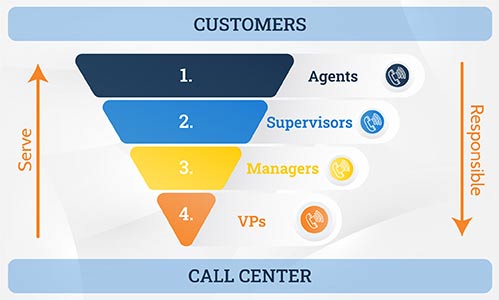What is Servant Leadership?
Servant leadership is a leadership style and philosophy whereby individuals interact with others to achieve authority rather than power. These leaders' have a servitude attitude and approach when working with other employees. Furthermore, they have a close relationship with customers and employees to make better decisions for delivering great customer service.
Historically, the call center industry has used in most cases a command-control leadership style. It has been SQM's experience that servant leadership style tends to be the exception versus the rule. However, it is also our view that under the right type of conditions, the servant leadership style can be highly effective for creating a customer service-centric culture.
In many cases, the servant leadership style approach uses an upside-down customer hierarchy pyramid structure. By inverting the pyramid, leaders serve two types of customers. The first type is an internal customer, which is employees, and the second type is the external customer who uses the company's products and services.

Upside Down - Customer Hierarchy Pyramid Structure
As shown in the below figure, the traditional pyramid hierarchy must be turned upside down so that those closest to the customers, the Agents, are on top. This means that Agents are responsible and accountable for resolving customer calls and for providing great customer service.
The upside-down customer hierarchy pyramid structure requires a servant leadership style by all managers to effectively deliver a great customer service experience. For example, supervisors, managers, and VPs serve Agents and ensure that they have the necessary skills, tools, and authority to provide world-class customer service. Therefore, Agents should be viewed as internal customers by all levels of management in the call center.
If the needs and desires of the Agents are not responded to, the Agents will not provide world-class customer service. But, on the other hand, when Agents are treated as responsible owners for delivering world-class customer service, they will provide great customer service.
Figure 1: Customer Hierarchy Pyramid Structure

By inverting the pyramid, senior call center managers recognize that they have two types of customers. The first type is an internal customer who works in the call center (Agents), and the second type is the external customer who calls the call center. Looking at it from this perspective makes it more evident how essential Agents are to ensuring that customers experience excellent service.
The whole notion that VPs serve Agents to help them deliver a great customer experience (CX) requires a mind shift. Unfortunately, it is difficult for many senior call center managers to embrace, as they are used to working in the traditional hierarchy, where they sit on the top and Agents sit on the bottom.
Another challenge for management is when Agents are underperforming or have behavioral issues. Why would you treat the Agents as internal customers under those conditions? The answer is that you do not; address the performance or behavioral issues by using your normal performance improvement plan process to try to rectify the performance or behavioral issues.
When management utilizes servant leadership style and the inverted hierarchy pyramid, they must make it clear to Agents that they are still held accountable for their performance and how they conduct themselves in the working environment.
Quick Related Links
First Call Resolution Definition First Call Resolution PPT First Call Resolution Benefits
First Call Resolution Strategies First Call Resolution Operating Philosophy Call Handling Call Study Why Great Customer Service Matters CRM Average Speed of Answer Call Resolution Delivery Model Concierge Service Handling Customer Complaints VoC Performance Management
